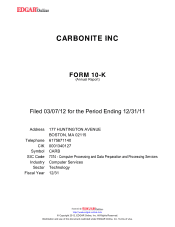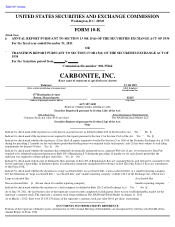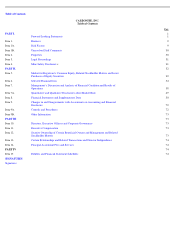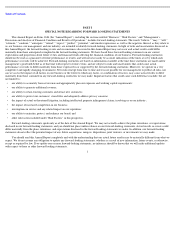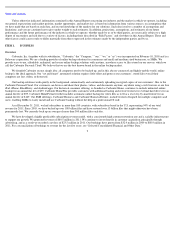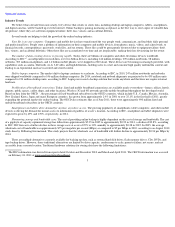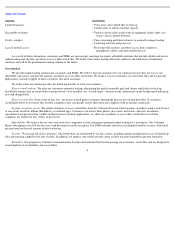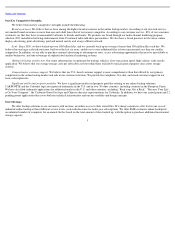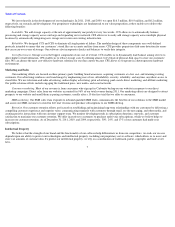Carbonite 2011 Annual Report Download - page 6
Download and view the complete annual report
Please find page 6 of the 2011 Carbonite annual report below. You can navigate through the pages in the report by either clicking on the pages listed below, or by using the keyword search tool below to find specific information within the annual report.
Table of Contents
Industry Trends
We believe that a decade from now nearly every device that creates or stores data, including desktop and laptop computers, tablets, smartphones,
and digital cameras, will be backed up over the internet. Online backup is gaining increasing acceptance as the best way to store copies of valuable data
off-premise, where they are safe from equipment failure, theft, loss, viruses, and accidental deletion.
Several trends are helping to fuel the growth of the online backup industry:
Your life is on your computer. Computers and mobile devices have transformed the way people work, communicate, and lead their daily personal
and professional lives. People store a plethora of information on their computers and mobile devices, from photos, music, videos, and school work, to
financial records, correspondence, passwords, work files, and tax returns. These files could be permanently destroyed due to equipment failure, theft,
loss, viruses, and accidental deletions. Often these files are accumulated over time and are irreplaceable, making their loss devastating for the owner.
The number of data-creating devices is growing rapidly. Today, there are billions of computers and other electronics devices worldwide.
According to IDC *
,
an independent research firm, over two billion devices, including 146 million desktops, 209 million notebooks, 38 million
netbooks, 303 million smartphones, and 1.4 billion mobile phones, were shipped in 2010 alone. These devices are becoming increasingly powerful, with
capabilities such as camera, bluetooth, wi-fi, 3-D video, and high definition, enabling users to create and consume high quality multimedia content and
leading to an exponential increase in created and stored content.
Shift to laptop computers. The market shift to laptops continues to accelerate. According to IDC, in 2010, 247 million notebooks and netbooks
were shipped worldwide compared to 146 million desktop computers. By 2014, notebook and netbook shipments are projected to be 439 million units
compared to 154 million desktop units, according to IDC. Laptop users need a backup solution that works anywhere and that does not require external
hardware.
Proliferation of broadband connections. Today, fixed and mobile broadband connections are available nearly everywhere –
homes, offices, hotels,
airports, public spaces, coffee shops, and other locations. Wireless 3G and 4G networks provide mobile broadband throughout the developed world.
Based on data from the OECD , the percentage of fixed broadband subscribers in the OECD countries, which include U.S., Canada, Mexico, Australia,
New Zealand, Korea, Japan and many European countries, has grown from approximately 2.9% in 2001 to over 25.1% in the first half of 2011, greatly
expanding the potential market for online backup. The OECD also estimates that as of June 2011, there were approximately 900 million fixed and
mobile broadband subscribers in the OECD countries.
Smartphones and tablets drive demand for anytime, anywhere access. The growing popularity of smartphones, tablet computers, and other mobile
devices is driving the demand for instant access to information regardless of a user’s location. According to IDC, smartphone and tablet shipments were
expected to grow by 49% and 170%, respectively, in 2011.
Plummeting storage and bandwidth costs. The cost of providing online backup is highly dependent on the cost of storage and bandwidth. The cost
of a gigabyte of capacity-optimized storage has fallen from approximately $5.35 in 2005 to approximately $0.92 in 2011, a decline of 82.8%, according
to IDC. IDC forecasts a further decline in these storage costs at a rate of 25% to 30% annually to approximately $0.28 in 2015. In 2005, the average
wholesale cost of bandwidth was approximately $75 per megabits per second (Mbps) as compared to $5 per Mbps in 2010, according to an August 2010
study done by DrPeering International. This study projects that the wholesale cost of bandwidth will further decline to approximately $0.94 per Mbps by
2014.
There are multiple alternatives currently available for backing up data, such as external hard disk drives, flash memory drives, CDs, DVDs, and
tape backup drives. However, these traditional alternatives are limited by drive capacity, cumbersome to scale, prone to failure, not secure, and not
accessible from a remote location. Traditional hardware solutions for storing data have the following limitations:
3
The IDC information was derived from reports dated October and December 2010 and March and April 2011. The OECD information was accessed
on February 24, 2011 at
www.oecd.org/sti/ict/broadband
.
*
*

